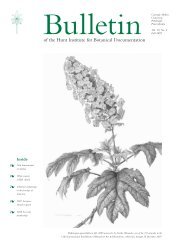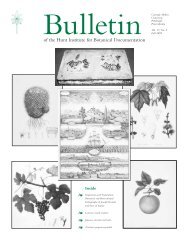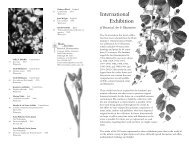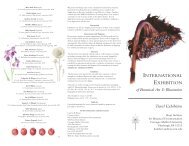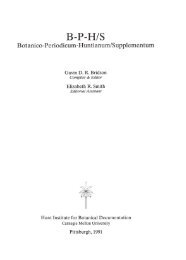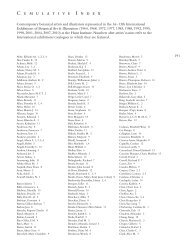Bulletin - Hunt Institute for Botanical Documentation - Carnegie ...
Bulletin - Hunt Institute for Botanical Documentation - Carnegie ...
Bulletin - Hunt Institute for Botanical Documentation - Carnegie ...
You also want an ePaper? Increase the reach of your titles
YUMPU automatically turns print PDFs into web optimized ePapers that Google loves.
Notes from the Field<br />
A busy summer<br />
This was a summer <strong>for</strong> making and<br />
strengthening connections with<br />
colleagues. In June I travelled to Sweden<br />
<strong>for</strong> a Linnaeus Link meeting. In July I<br />
attended the Council on <strong>Botanical</strong> and<br />
Horticultural Libraries (CBHL) meeting<br />
in Denver, Colorado. And between<br />
these trips, we were pleased to welcome<br />
Cees Lut, Chief Librarian of the National<br />
Herbarium of The Netherlands, Leiden,<br />
<strong>for</strong> a three-day visit to <strong>Hunt</strong> <strong>Institute</strong>.<br />
The trip to Sweden was my first.<br />
My hosts were Tomas Anfålt and his<br />
wife Maj-Lis, whose home is located<br />
between Uppsala and Stockholm. One<br />
of Tomas’ many projects is editing the<br />
correspondence of Carl Linnaeus (1707–<br />
1778) and making parts of it accessible on<br />
the Web at www.c18.org/pr/lc/index.<br />
html. It was at his instigation that<br />
the Linnaeus Link project was begun.<br />
Maj-Lis works at the Stockholm City<br />
Library in a beautifully designed and<br />
architecturally famous building that was<br />
constructed between 1924 and 1927. The<br />
first day of my trip they took me to the<br />
Uppsala Botaniska Trädgård, where we<br />
viewed an intriguing exhibit by Danish<br />
horticultural artist Tage Andersen.<br />
The previous five Linnaeus Link meetings<br />
were in London, and I represented <strong>Hunt</strong><br />
<strong>Institute</strong> at three of them. The invitation<br />
from our Swedish members to meet in<br />
Sweden gave us a great opportunity to<br />
visit the major Linnaean sites, many of<br />
us <strong>for</strong> the first time. The meeting took<br />
place on 8–9 June 2001 in Stockholm<br />
and Uppsala. The primary session was<br />
held at The Royal Swedish Academy of<br />
Sciences, and items discussed included<br />
further development of an agreement in<br />
principle among the project collaborators;<br />
possible digitization projects; an update<br />
on the survey of Linnaean collections; a<br />
decision to make the survey results (in<br />
EAD-equivalent MARC <strong>for</strong>mat) and<br />
progress report accessible on the Web; a<br />
cataloging workshop <strong>for</strong> those working<br />
on the union list of Linnaean materials;<br />
and various fundraising possibilities.<br />
In addition to the meeting discussions,<br />
the group visited a number of interesting<br />
sites. On Friday in Stockholm, we visited<br />
8 Bull. <strong>Hunt</strong> Inst. Bot. Doc. 13(2), Fall 2001<br />
Linnaeus Link group meets in Sweden, shown here in<strong>for</strong>mally during a tour of Skokloster Castle.<br />
Pictured front, left to right: Anne Freeman, The Natural History Museum; Charlotte Tancin, <strong>Hunt</strong><br />
<strong>Institute</strong> <strong>for</strong> <strong>Botanical</strong> <strong>Documentation</strong>; Christer Wikstrom, The Royal Swedish Academy of Sciences,<br />
Center <strong>for</strong> History of Science. At back, left to right: Maj-Lis Anfålt (guest); Carol Gokce, The Natural<br />
History Museum; Graham Jefcoate, The British Library; Tomas Anfålt, Project Linnaeus. Present at<br />
the meeting but absent from this photo were Torsten Schlichtkrull, Danish National Library of Science<br />
and Medicine, and Gina Douglas, Linnean Society of London (who took the photo).<br />
the Stockholm University Library and<br />
met with library director Gunnar Salin<br />
and also with botanist Bengt Jonsell,<br />
editor-in-chief of Flora Nordica, who<br />
took us to see some of the library’s rare<br />
books on natural history. On Saturday<br />
we met at the University of Uppsala’s<br />
Carolina Rediviva library, where we<br />
had a behind-the-scenes tour of the<br />
special collections and the Linnaean<br />
material. Tomas and Viveca Norberg,<br />
Chief of Manuscripts and Music, showed<br />
us the only known complete copy of<br />
volume one of Rudbeck’s Campi Elyssi,<br />
1701–1702, the other copies having been<br />
burned in the great fire of Uppsala.<br />
Perhaps about 40 copies of volume two<br />
are still extant. We saw Linnaeus’ 1729<br />
manuscript of Adonis Laplandicus, which<br />
had been in Rudbeck’s collection, and<br />
the famous Leufsta copy of Besler’s Hortus<br />
Eystettensis. The library also was showing<br />
an exhibit of treasures from their special<br />
collections, including a map of Mexico<br />
city drawn by Alonso de Santa Cruz<br />
in 1555, a Norwegian 13th-century<br />
manuscript of the Saga of St. Olof, a copy<br />
of the Codex Argentus “Silver Bible” from<br />
the early 6th century, and Linnaeus’<br />
1729 manuscript of Praeludia Sponsaliorum<br />
Plantarum.<br />
After this tour we walked into the town<br />
center <strong>for</strong> lunch and then on to the<br />
Linnémuseet (Linnaeus Museum) and<br />
the Linnaean <strong>Botanical</strong> Garden. En<br />
route we stopped at the cathedral to<br />
see the memorial stone beneath which<br />
are buried Linnaeus and his wife and<br />
son. Then we went on to the museum<br />
— this was so exciting, being right there<br />
at these sites where Linnaeus walked,<br />
talked and taught. We were given a<br />
good tour by curator Eva Björn, and<br />
we saw the Lapland drum, the Linnaea<br />
borealis china, and some of the zoological<br />
specimens. Upstairs in the room where<br />
he lectured, we saw the Hoffman<br />
painting of Linnaeus in Lapland dress<br />
and another painting of the bust of<br />
Linnaeus being honored, which was<br />
later reproduced in Thornton’s Temple of<br />
Flora. On leaving the museum we saw<br />
the Linnaeus <strong>Botanical</strong> Garden, where<br />
plantings are done in the order set out in<br />
Species Plantarum. Then we went by car<br />
to Hammarby, Linnaeus’ country home.<br />
We saw the Plumier plates pasted to the<br />
walls of Linnaeus’ study, the colored<br />
Ehret plates pasted to the walls of his<br />
bedroom, and the “sailfish” hanging<br />
from the ceiling of his small natural<br />
history museum behind the house.<br />
On the next day, most of the group met<br />
<strong>for</strong> a tour of Skokloster Slott (Castle),<br />
after which the British members would<br />
be flying back to England. The castle’s<br />
librarian, Elizabeth Westin, gave us<br />
a special tour of the library, which is



